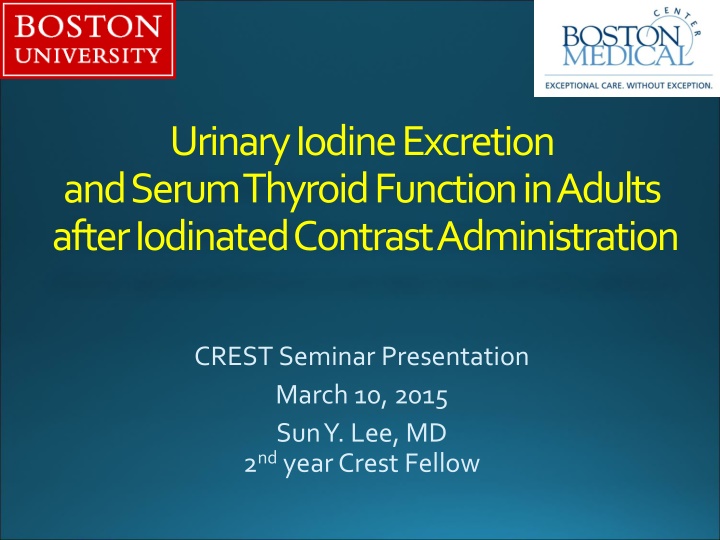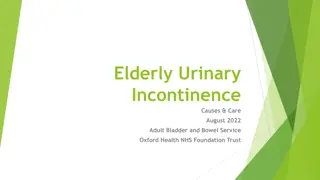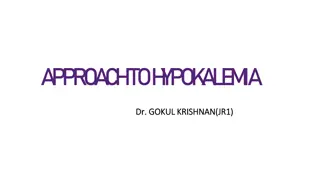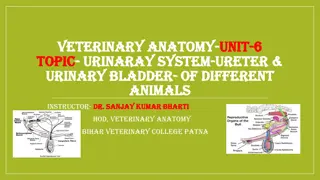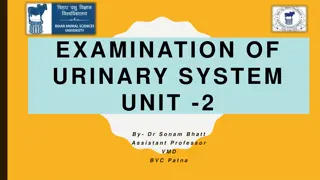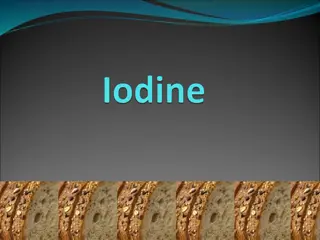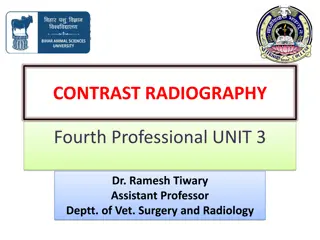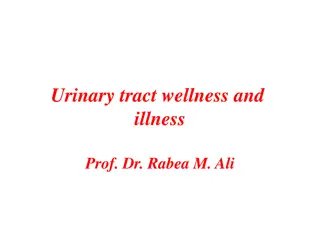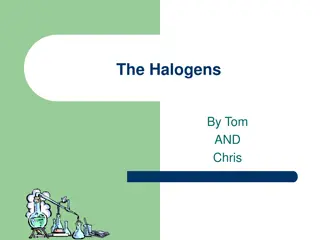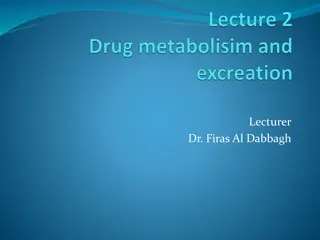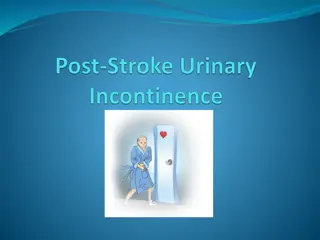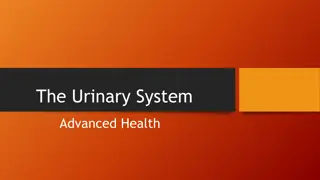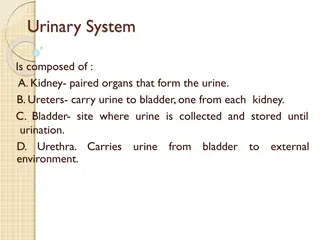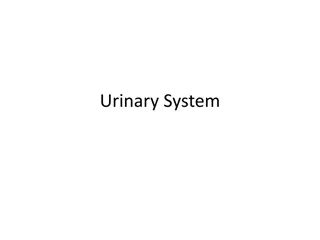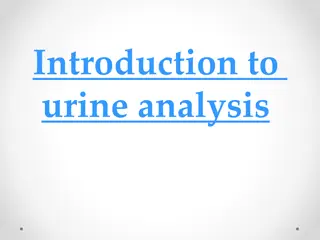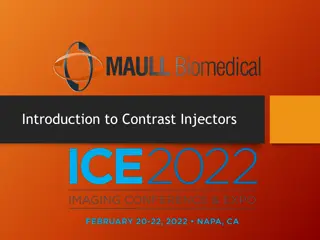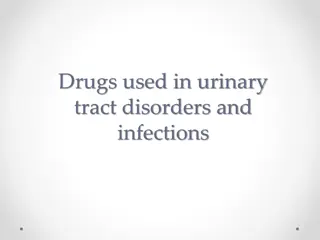Urinary Iodine Excretion After Iodinated Contrast: Implications and Findings
Examine the impact of iodinated contrast media on urinary iodine clearance and serum thyroid function in adults. Learn about the epidemiology of CT scan iodine exposure and the potential risks associated with excess iodine. Discover the importance of monitoring urinary iodine clearance post-administration. Explore studies on urinary iodine excretion in patients post-thyroidectomy and its implications for thyroid health.
Download Presentation

Please find below an Image/Link to download the presentation.
The content on the website is provided AS IS for your information and personal use only. It may not be sold, licensed, or shared on other websites without obtaining consent from the author.If you encounter any issues during the download, it is possible that the publisher has removed the file from their server.
You are allowed to download the files provided on this website for personal or commercial use, subject to the condition that they are used lawfully. All files are the property of their respective owners.
The content on the website is provided AS IS for your information and personal use only. It may not be sold, licensed, or shared on other websites without obtaining consent from the author.
E N D
Presentation Transcript
Urinary Iodine Excretion and Serum Thyroid Function in Adults after Iodinated Contrast Administration CREST Seminar Presentation March 10, 2015 Sun Y. Lee, MD 2ndyear Crest Fellow
Overview Excess iodine exposure from iodinated contrast media and its implications Literature on urinary iodine clearance after iodinated media exposure Study Design Results Conclusion
Overview Excess iodine exposure from iodinated contrast media and its implications Literature on urinary iodine clearance after iodinated media exposure Study Design Results Conclusion
Epidemiology There has been a nearly 3-fold increase in CT examinations from 1996 to 2010, with approximately 70 million CT scans being performed annually in 2007. With increased use of CT scans, exposure to huge amounts of iodine from radiographic contrast media is also increasing. Iodine content in radiographic contrast media = 320 mg/ml to 370 mg/ml, while RDA of iodine is 150 mcg. Smith-Bindman, R. et al. JAMA 2012;307(22):2400-2409
Why are We Interested in the Urinary Iodine Clearance after ICM Administration? Timing of radioactive iodine ablation after thyroidectomy for thyroid cancer Timing of radioactive iodine treatment and/or diagnostic uptakes and scans for hyperthyroidism (Graves disease or toxic multinodular goiter) Potential for development of thyroid dysfunction from exposure to excess iodine.
Overview Excess iodine exposure from iodinated contrast media and its implications Literature on urinary iodine clearance after iodinated media exposure Study Design Results Conclusion
Urinary Iodine Excretion after ICM Exposure in Patients s/p Total Thyroidectomy Prospective study 25 patients s/p total thyroidectomy for thyroid cancer UIC back to baseline by one month Padovani, R. et al. Thyroid. 2012;22(9):926-930
Urinary Iodine Excretion after ICM Exposure in Patients s/p Total Thyroidectomy Retrospective study of 1023 patients with differentiated thyroid cancer. Five different time intervals between preoperative CT scan and spot urinary iodine measurements. No significant difference between UIC one month and 6 months after CT scan. Comparison of urinary iodine concentration according to time interval between CT scan and urine iodine measurements. Sohn, et al. Thyroid 2014; 24(5): 872-877.
Urinary Iodine Excretion after ICM Exposure in Patients without Thyroid Disease Prospective study 21 patients without reported hxof thyroid disease UIC measured every 2 weeks after ICM exposure for 12 weeks Thyroid function not assessed. Nimmons, GL. et al. JAMA Otolaryngol Head Neck Surg. 2013;139(5):479-482
Comparison of Urinary Iodine Clearance between Athyreotic Patients and Patients with Intact Thyroid Glands Prospective study 6patients with thyroid cancer s/p total thyroidectomy vs. to 7 euthyroid controls. UIC assessed every 2 weeks up to 2 months, then monthly up to 6 months after CT scan. No difference in time to normalization of UIC between the two groups. No thyroid function tests. Ho, et al. Journal of Thyroid Research, 2014;article ID 580569
Overview Excess iodine exposure from iodinated contrast media and its implications Literature on urinary iodine clearance after iodinated media exposure Study Design Results Conclusion
Study Objectives To determine the time required for UIC to normalize following iodinated contrast media (ICM) exposure in clinically euthyroid adults. To assess any potential changes in serum thyroid function following ICM exposure. To assess for any potential predictors of time to normalization of UIC and serum thyroid dysfunction following ICM exposure
Study Subjects Inclusion criteria Age 18 yr undergoing elective CT scan with iodinated contrast agent Exclusion criteria ICM exposure 6 months Known thyroid dysfunction or use of thyroid medications Amiodarone 2 years Lithium 6 months Current pregnancy or lactation Unable to give informed consent
Methods Baseline Follow-up Extended Follow-up Wk 6-24 - Biweekly Week 0 at CT Wk 1-4 - Weekly Only if UIC not back to baseline at Week 4 Measurements Spot UIC and TFTs at every visit Thyroid ultrasound within the first 4 weeks of follow-up.
Outcomes of Interest Primary outcomes Median time for UIC to peak Median time for UIC to return to 1.5 x baseline or below 164 mcg/L (national median), whichever comes first Secondary outcomes Predictors of primary outcomes Pattern of changes in thyroid function over study period Predictors for developing incident thyroid dysfunction
Statistical Analyses Pearson s rank correlation and binomial analyses to determine univariate associations between various predictors and peak UIC, duration to peak or normalization of UIC, and development of incident thyroid dysfunction. Mixed effects models to assess potential changes in serum thyroid function tests during the study period for each subject. Multivariate linear regression models to assess potential predictors of peak UIC, duration to peak UIC, and duration to normalization of UIC. Multivariate logistic regression model to asses predictors for the development of incident thyroid dysfunction.
Statistical Analyses Potential predictors assessed were: Age, gender, race, smoking status, place of birth, personal or family history of autoimmune disease, family history of thyroid disease Presence of thyroid nodules 1cm and thyroid volume Baseline UIC Baseline serum TSH, free T4 (FT4), total T3 (TT3), and TPO antibody. Subjects with abnormal serum thyroid function at baseline were excluded from analyses assessing development of incident thyroid dysfunction and change in thyroid function over time.
Overview Excess iodine exposure from iodinated contrast media and its implications Literature on urinary iodine clearance after iodinated media exposure Study Design Results Conclusion
Baseline Characteristics of Subjects n=54, except *n=51 Mean SD or Median (Range) Age (years) Amount of iodine administered (grams) 50.8 12.4 34.5 6.1 UIC at baseline ( g/L) 105.6 (10.0-866.1) TSH at baseline (mIU/L)* 1.26 (0.5-11.2) FT4 at baseline (ng/dL)* 0.83 (0.47-1.34) TT3 at baseline (ng/mL)* 1.40 (0.71-2.34) 57% Men, 48% White, 37% Black, and 11% Hispanic. 15% with thyroid nodule 1cm. One subject with positive Thyroid Peroxidase antibody titer.
Descriptive statistics Mean SD time to achieve peak UIC = 1.1 0.5 weeks. Median (range) peak UIC = 3,519 (233-157,500) g/L. Mean SD time to normalization of UIC = 5.2 4.0 weeks.
Median Urinary Iodine Concentrations following ICM Administration 4000 3519 3500 Median UIC (mcg/L) 3000 2500 2000 1500 1000 570346264 329 500 190 157 146 145 105 0 0 2 4 6 8 10 12 14 16 18 20 Week after ICM administration
Development of Incident Thyroid Dysfunction after ICM Administration 11 subjects (22%) developed abnormal serum TSH concentrations within 1-4 weeks after ICM administration Five with suppressed TSH One with T3 thyrotoxicosis Four with subclinical hyperthyroidism Six with elevated TSH Four with overt hypothyroidism (with low free T4) Two with subclinical hypothyroidism
Univariate Correlations between Covariates and Duration to Normalization of UIC after ICM Administration Covariates Correlation Coefficient 0.024 -0.207 P-value 0.87 0.137 Age (years) Amount of iodine received (grams) Thyroid volume (cm3) Baseline UIC (mcg/L) Peak UIC (mcg/L) Duration to peak UIC (weeks) 0.017 -0.219 -0.047 0.026 0.90 0.116 0.74 0.86 Baseline TSH ( IU/L)* 0.075 0.61
Univariate Correlations between Covariates Moderate positive correlation between amount of iodine received and peak UIC (r=0.649; p<0.001). Moderate inversecorrelation between baseline TSH and time to achieve peak UIC (r=-0.283; p=0.049). The lower the baseline TSH, the longer it took to achieve peak UIC.
Univariate Correlations between Covariates and Development of Incident Thyroid Dysfunction after ICM Administration Covariates Correlation Coefficient Age (years) Amount of iodine received (grams) Thyroid volume (cm3) -0.091 Baseline UIC (mcg/L) -0.143 Peak UIC (mcg/L) -0.056 Duration to peak UIC (weeks) Duration to normalization of UIC (weeks) Baseline TSH ( IU/L) P-value 0.75 0.51 0.047 0.096 0.53 0.33 0.70 0.70 -0.056 0.076 0.60 0.194 0.18
Multivariate Linear Regression Model Predicting Peak UIC after ICM Administration Predictors Age (years) Amount of iodine received (grams) Thyroid volume (cm3) Presence of nodules 1cm Gender Race/ethnicity Smoking status Place of birth History of autoimmune disease Family history of thyroid disease Family history of autoimmune disease Overall model p-value = 0.035 Beta-coefficient 695.45 2866.31 -215.29 2899.08 N/A N/A N/A N/A N/A N/A N/A p-value 0.024* <0.001* 0.77 0.67 0.34 0.77 0.98 0.76 0.40 0.47 0.05 Baseline UIC (mcg/L) Baseline TSH (mIU/L) Baseline FT4 (ng/dL) Baseline TT3 (ng/mL) -3.97 -471.90 -2890.39 -2877.18 0.83 0.76 0.90 0.57
Multivariate Regression Models No significant predictors of Duration to achieve peak UIC (p=0.55) Duration to normalization of UIC (p=0.44) Development of incident thyroid dysfunction (p=0.29)
Overview Excess iodine exposure from iodinated contrast media and its implications Literature on urinary iodine clearance after iodinated media exposure Study Design Results Conclusion
Conclusion It would be prudent to wait at least 2 months after CT with ICM before radioactive iodine is given for thyroid scans or therapy. Monitoring of thyroid function should be considered in at-risk patients, as 22% of subjects developed abnormal thyroid function after a single ICM dose.
Acknowledgement Dr. Lewis Braverman Dr. Elizabeth Pearce Dr. Angela Leung Dr. Donny Chang Dr. XuemeiHe Boston University Medical Center General Clinical Research Unit staff East Newton Campus Radiology Staff NIH T32 grant CREST fellowship grant
Baseline Serum Thyroid Function Abnormalities Three subjects with both elevated TSH and total T3 levels: presumably from either heterophlic antibodies interfering with assay or recovery from non-thyroidal illness. Two subjects with elevated baseline TSH levels with normal free T4 and total T3 concentrations. Subsequently, data from 49 subjects were used in analyses of serum thyroid function. Data from the whole cohort (54 subjects) were used in analyses of urinary iodine concentrations.
Summary of Findings The largest prospective study assessing urinary iodine clearance after ICM administration (n=54). Baseline UIC 105.6 g/L (national median 164 g/L). Median peak UIC was 3519 g/L, but highest peak UIC was 157,500 g/L after single dose of ICM. UIC peaked at a mean of 1.1 weeks and normalized by a mean of 5.2 weeks after administration of a single dose ICM for routine CT scans in clinically euthyroidpatients with intact thyroid glands. No significant predictors of time to normalization of UIC. 22% (11 subjects) developed incident thyroid dysfunction.
Strength of Our Study The largest prospective study to date assessing urinary iodine excretion after iodinated contrast media administration. Assessment of thyroid function in patients with intact thyroid glands. Assessment of thyroid morphology (size of the gland and presence of thyroid nodules)
Limitations of Our Study Lack of data on subjects thyroid radioactive iodine uptake Radioactive iodine uptake data would have added information on the status of iodine saturation in thyroid gland.
